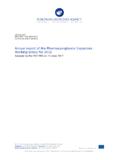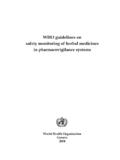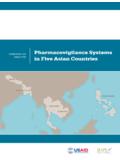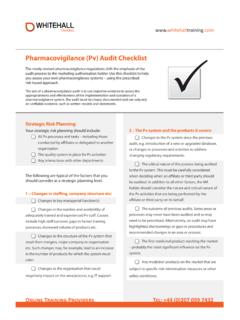Transcription of WHO PHARMACOVIGILANCE INDICATORS: A …
1 WHO PHARMACOVIGILANCE INDICATORS: a practical manual FOR THE ASSESSMENT OF PHARMACOVIGILANCE SYSTEMSWHO PHARMACOVIGILANCE indicatorsA practical manual for the assessment of PHARMACOVIGILANCE systemsWHO Library Cataloguing-in-Publication DataWHO: PHARMACOVIGILANCE indicators: a practical manual for the assessment of PHARMACOVIGILANCE systems. Side Effects and Adverse Reactions epidemiology. Monitoring. Health Organization. ISBN 978 92 4 150825 4 (NLM classification: QV 771) World Health Organization 2015 All rights reserved. Publications of the World Health Organization are available on the WHO website ( ) or can be purchased from WHO Press, World Health Organization, 20 Avenue Appia, 1211 Geneva 27, Switzerland (tel.)
2 : +41 22 791 3264; fax: +41 22 791 4857; e-mail: Requests for permission to reproduce or translate WHO publica-tions whether for sale or for non-commercial distribution should be addressed to WHO Press through the WHO website ( ).The designations employed and the presentation of the material in this publication do not imply the expression of any opinion whatsoever on the part of the World Health Organization con-cerning the legal status of any country, territory, city or area or of its authorities, or concerning the delimitation of its frontiers or boundaries. Dotted and dashed lines on maps represent ap-proximate border lines for which there may not yet be full mention of specific companies or of certain manufacturers products does not imply that they are endorsed or recommended by the World Health Organization in preference to others of a similar nature that are not mentioned.
3 Errors and omissions excepted, the names of propri-etary products are distinguished by initial capital reasonable precautions have been taken by the World Health Organization to verify the information contained in this publication. However, the published material is being distributed without warranty of any kind, either expressed or implied. The responsibility for the interpreta-tion and use of the material lies with the reader. In no event shall the World Health Organization be liable for damages arising from its use. Designed by minimum graphicsPrinted in FranceiiiContentsAcknowledgements vAbbreviations viHow to use this manual vii1.
4 Introduction 12. PHARMACOVIGILANCE indicators 4 Definition 4 Rationale and objectives of PHARMACOVIGILANCE indicators 4 Characteristics of ideal PHARMACOVIGILANCE indicators 5 Classification (type) of PHARMACOVIGILANCE indicators 53. The context of WHO PHARMACOVIGILANCE indicators 7 WHO strategy for monitoring a country s pharmaceutical situation 7 How the WHO PHARMACOVIGILANCE indicators were developed 74. Categories of WHO PHARMACOVIGILANCE indicators 9 Core PHARMACOVIGILANCE indicators 9 Complementary indicators 12 Indicators for public health programmes 155. Data sources 16 indicator format 166. Description of core indicators 18 Core structural indicators 18 Core process indicators 25 Core outcome or impact indicators 327.
5 Description of indicators for a public health programme 41 References 53 Further reading 55 Annexes 57 Annex 1: Minimum requirements for a functional PHARMACOVIGILANCE system 59 Annex 2: Background information 61 Annex 3: Assessment checklist 63vAcknowledgementsSpecial thanks are due to Ambrose Isah, University of Benin, Nigeria (Chairman, National Drug Safety Advisory Committee, Nigeria), for leading the work on identifying the candidate indicators for PHARMACOVIGILANCE systems and for preparing the first draft of this publication. The contributions from the national PHARMACOVIGILANCE centres of countries participating in the WHO Programme for International Drug Monitoring were critical to the content development and are gratefully acknowledged.
6 Members of the WHO Advisory Committee on the Safety of Medicinal Products (ACSoMP) provided guidance at every stage. Marthe Everard, Jos Luis Castro, Lahouari Belgharbi and Lembit R go (WHO) provided useful comments and advice. Shanthi N. Pal (WHO), Sten Olsson (Uppsala Monitoring Centre) and Serge Xueref (consultant) critically reviewed and edited the entire manuscript for technical content and consistency. Susan Kaplan and Geoffrey Bowring (Uppsala Monitoring Centre) edited the publication for grammar and for conformity with WHO house style. Leticia Megias Lastra (consultant) assisted with the cover adverse drug reactionACSoMP Advisory Committee on Safety of Medicinal ProductsCP core process indicatorCST core structural indicatorHCP health-care providerICSR individual case safety reportPSUR periodic safety update reportMAH marketing authorization holdersQPPV qualified person for pharmacovigilanceUMC Uppsala Monitoring CentreWHO World Health OrganizationviiHow to use this manualThis manual provides a practical method for determining the pharmaco-vigilance indices.
7 It is designed to be simple and can be understood by any worker in PHARMACOVIGILANCE without formal training in monitoring and evaluation. This should ensure its routine use in PHARMACOVIGILANCE establish-ments. The current manual is published as version 1 ( ), to underscore its evolving nature: feedback from user groups is welcomed and will be used in developing the subsequent as a medical discipline is crucial in preventing medicine-related adverse effects in humans, promoting patient safety, and the rational use of medicines. The indicators proposed in this manual are based on the expected functions of PHARMACOVIGILANCE centres as described in the WHO Mimimum Requirements for a Functional PHARMACOVIGILANCE System (1) (see Annex 1 of the manual ).
8 The structural, process and outcome or impact indicators will reflect the ex-istence of PHARMACOVIGILANCE facilities, the dynamics in the set-up, and the eventual outcomes, indicators are further classified as either core or complementary. The core indicators address important PHARMACOVIGILANCE issues and provide information which should be readily available to enable determination of the PHARMACOVIGILANCE status of the setting and allow for comparison with other The complementary indicators are relevant and should be determined when necessary to provide additional information in the sphere of understand the indicator values, it is important to obtain the necessary background information (as shown in Annex 2), which will allow for a clear appreciation of where the data are obtained as well as providing the denomi-nator for calculating some of the indicators.
9 The section on description of the indicators provides information on the nature of the indicators and how to obtain For the purposes of this manual , the word setting will be used to refer to various pharmaco-vigilance establishments, such as national or regional centres, hospital facilities, and public health programmes where activities relating to PHARMACOVIGILANCE are in place or expected to be in place. viiiWHO PHARMACOVIGILANCE INDICATORSThe indicators are expected to give a panoramic view of the pharmaco-vigilance landscape. Some of the indices may be measured annually or more frequently. However, for indices requiring epidemiological studies, surveys, and/or research which is likely to be cost-intensive (both financial cost and personnel time), measurements should be less frequent, in some instances every 5 years.
10 This is especially true for indicators that measure the outcome or impact of various PHARMACOVIGILANCE activities, which often require consid-erable resources and manual should be used as a tool for quality assurance and improvement: repeated measures of the indicators over time will allow an assessment of progress. It is therefore hoped that appropriate use of this practical guide will allow for a better understanding of the PHARMACOVIGILANCE systems at national level, and ultimately, will lead to enhancement of PHARMACOVIGILANCE systems this manual , the word medicine denotes any substance or pharmaceutical product for human or veterinary use that is intended to modify or explore physiological systems or pathological states for the benefit of the recipient.















